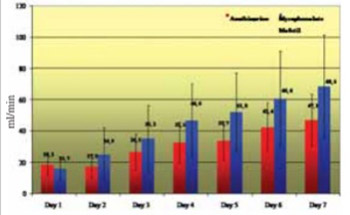Micophenolat Mofetil Versus Azathioprine: Effects on Renal Graft Function in Early Posttransplant Period
DOI:
https://doi.org/10.17305/bjbms.2009.2836Keywords:
immunosuppression, MMF, AZA, renal graft functionAbstract
All conventional immunosuppressive tree drugs-protocols are based on Cyclosporine; consisting of low doses of Cyclosporine (CsA), Azathioprine (AZA) or Mycophenolate Mofetil (MMF) and Prednisolone, AZA has been used in clinical transplantation for more than 30 years and was the first immunosuppres-sive agent to achieve widespread use in organ transplantation. MMF was introduced in clinical practice in 1995 after several clinical trials proved that it was more efficient than AZA for prevention of acute rejection episodes. Our aim was to evaluate influence of AZA and MMF on renal graft function in early post-transplant stage. Study recruited 74 patients who underwent kidney transplantation in University Clinical Centre Tuzla. All patients received CsA and corticosteroid-based immunosuppression, as a part of triple immunosuppressive regiment, 40 patients received AZA and 34 MMF. In order to assess renal graft function, following parameters were evaluated: glomerular filtration rate GFR (ml/min) creatinine clearance (CrCl) (ml/min), 24 h urine output (ml/day), and from the serum potassium, sodium, urea and creatinine (mmol/dm3). Significantly higher average values of 24 hour urine output were recorded during first seven postoperative days in patients receiving MMF compared to those treated with AZA. Serum creatinine values showed statistically significant decrease, starting with the second postoperative day, in MMF vs. AZA group (168,7±70,5 vs. 119,9±42,6; p<0,0007). GFR was significantly higher in MMF compared to the AZA group of patients. On the first post-transplant day CrCl was higher in AZA group (24,3±10 vs. 17,5±7,3; p=0,01), next six days situation is reversed CrCl is significantly higher in the MMF group (43,7±15 vs. 53, 4±22, 8 p=0,006). MMF vs. AZA therapy was associated with protective effect against worsening of renal function in first seven post-transplant days.
Citations
Downloads

Downloads
Published
How to Cite
Accepted 2017-12-13
Published 2009-05-20









